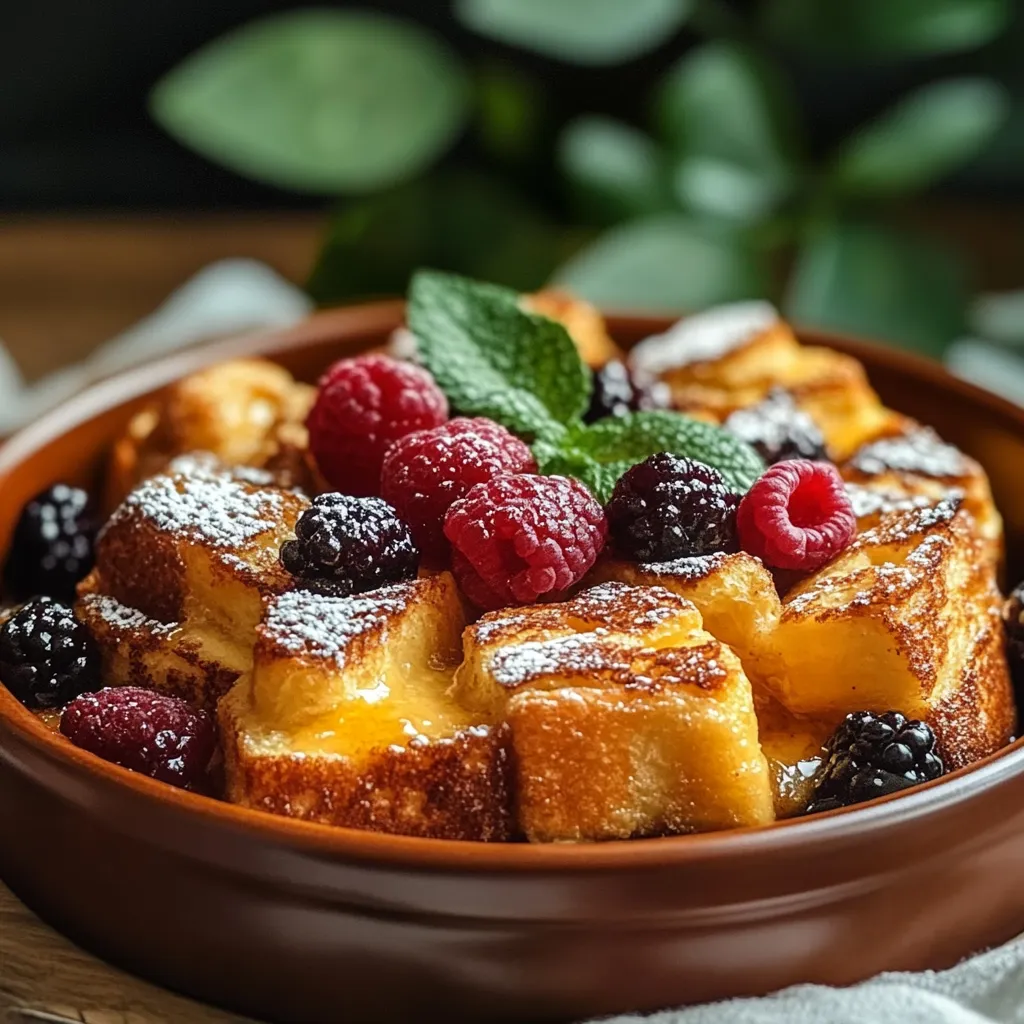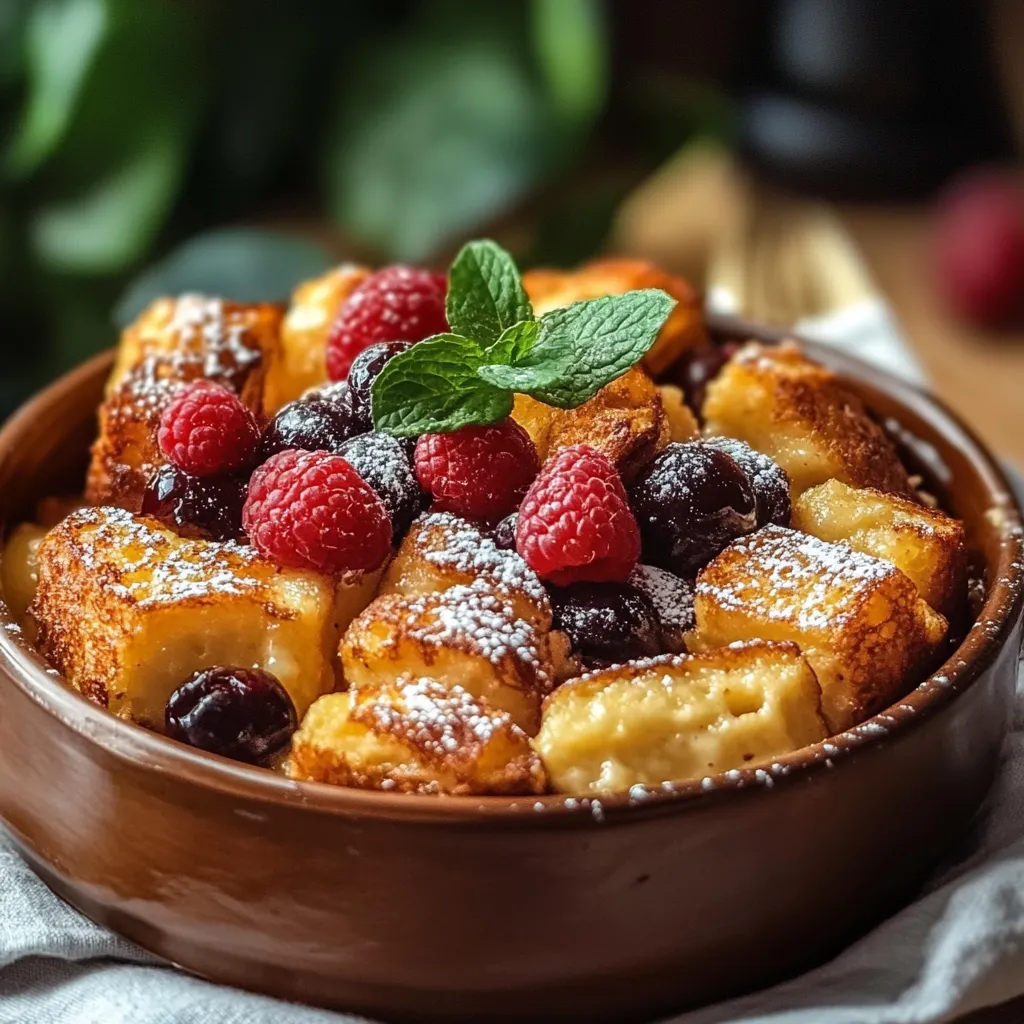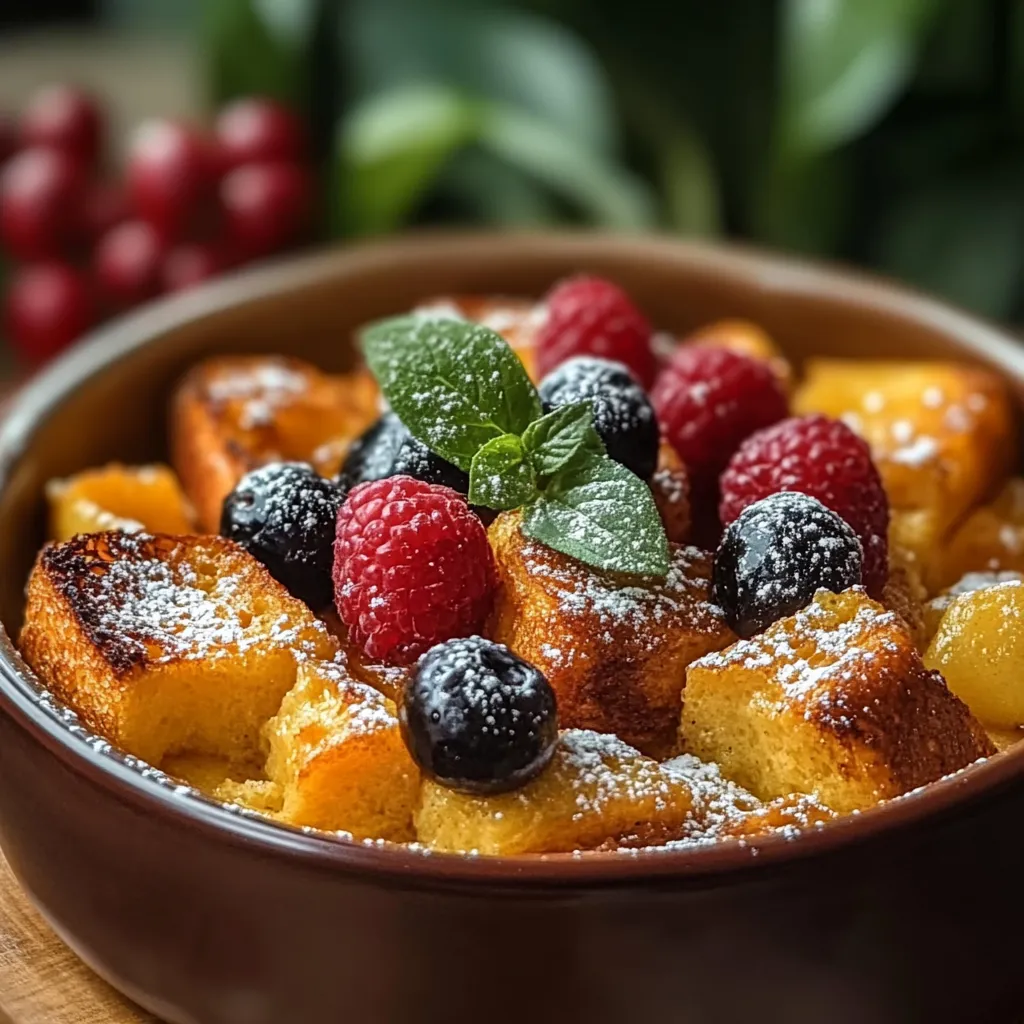 Pin it
Pin it
This overnight French toast casserole transformed my weekend breakfasts forever. When I need something special that doesn't require morning kitchen chaos, this recipe delivers impressive results with minimal effort. The bread soaks up the rich custard overnight, creating perfectly tender slices with crispy golden edges that will make everyone think you spent hours in the kitchen.
My family first tried this casserole during a holiday gathering when I needed something that could be prepared in advance. The reaction was so enthusiastic that it's now expected at every special breakfast or brunch, and even requested for breakfast-for-dinner nights.
Ingredients
- Brioche or challah bread: The pillowy texture and slight sweetness create the perfect foundation
- Large eggs: Provide structure and richness to the custard
- Whole milk and heavy cream: Create unmatched creaminess throughout
- Granulated sugar: Adds just enough sweetness without overpowering
- Vanilla extract: Provides warmth and depth of flavor
- Ground cinnamon and nutmeg: For that classic French toast aroma
- Maple syrup: Creates caramelization on top during baking
- Powdered sugar: Adds a beautiful finishing touch
- Optional toppings: Allow for personalization
Step-by-Step Instructions
- Prepare the Bread:
- Start with slightly stale bread if possible as it absorbs the custard better. Cut the bread into roughly 1-inch cubes, ensuring they're uniform for even soaking. The bread should fill your mixing bowl generously but not be packed too tightly.
- Make the Custard:
- Whisk the eggs first until completely smooth before adding the remaining wet ingredients. The milk and cream should be at room temperature to prevent the eggs from curdling when mixed. Add the spices last, whisking until the mixture looks uniform with tiny specks of spice visible throughout.
- Combine:
- Pour the custard over the bread in three batches, folding gently between each addition. This gradual approach ensures even distribution without crushing the bread cubes. Use a spatula to press down lightly, helping submerge any stubborn pieces that float to the top.
- Set Aside:
- Cover the bowl completely with plastic wrap, pressing it against the surface of the bread mixture to prevent any drying out. Refrigerate at least 4 hours, though overnight yields the best texture. The bread needs sufficient time to fully absorb the custard mixture.
- Preheat the Oven:
- Set your oven to 350°F and allow it to fully preheat before baking. Position the rack in the middle of the oven for even heat distribution.
- Bake the Casserole:
- Transfer the soaked bread mixture to a greased baking dish, maintaining an even layer with some pieces pointing upward for textural contrast. Drizzle maple syrup in a zigzag pattern across the top for caramelization. Bake until the top is deep golden brown and the center is set but still slightly jiggly.
- Cool and Serve:
- The short cooling period allows the custard to fully set while maintaining warmth. Dust powdered sugar through a fine mesh sieve from about 6 inches above for even distribution. Serve immediately while the contrast between crispy top and soft interior is at its peak.
 Pin it
Pin it
The vanilla extract is truly the unsung hero of this recipe. I upgraded to a high quality Madagascar bourbon vanilla extract a few years ago, and the difference was remarkable. The warm, complex notes completely transformed the dish from good to unforgettable.
Perfect Bread Selection
The foundation of an exceptional French toast casserole lies in the bread choice. Brioche offers a buttery richness that creates an almost dessert-like experience. Challah provides a slightly firmer texture with a subtle sweetness. Both breads have a tight crumb structure that holds up beautifully during the long soak without disintegrating. Avoid sandwich bread at all costs; it will collapse into a soggy mess. If you cannot find brioche or challah, a good quality French bread will work in a pinch but will yield a slightly less luxurious result.
Creative Variations
Transform this basic recipe with delicious additions mixed into the custard or layered throughout the casserole. Consider adding diced apples tossed with cinnamon for a fall inspired version, or layer in cream cheese chunks and blueberries for a cheesecake inspired twist. For chocolate lovers, fold in chocolate chips after the bread has soaked for a melty surprise within each serving. During the holidays, add orange zest and cranberries for a festive variation that brilliantly balances sweet and tart flavors. The versatility of this recipe makes it perfect for adapting to seasonal ingredients or personal preferences.
Serving Suggestions
Create a breakfast buffet experience by serving the casserole alongside various toppings in small bowls. Warm maple syrup is essential, but consider offering alternatives like blueberry compote, strawberry sauce, caramel drizzle, or even chocolate ganache. Fresh berries add brightness and visual appeal, while whipped cream provides a luxurious finish. For texture contrast, toasted pecans, sliced almonds, or candied walnuts make excellent additions. Complete the meal with crispy bacon or breakfast sausage to balance the sweetness with savory elements.
 Pin it
Pin it
This recipe is sure to become a cherished addition to your regular rotation, making your breakfasts and brunches truly unforgettable!
Frequently Asked Questions
- → Can I use a different type of bread?
Yes! While brioche and challah create the best texture due to their richness, you can substitute with French bread, sourdough, or even cinnamon raisin bread. Just ensure the bread is slightly stale or dried out to better absorb the custard mixture without becoming soggy.
- → How far in advance can I prepare this casserole?
You can prepare the casserole up to 24 hours in advance. The minimum soaking time is 4 hours, but overnight (8-12 hours) yields the best flavor and texture. This makes it perfect for holiday mornings or brunch gatherings.
- → Can I add fruit to the casserole?
Absolutely! You can add sliced apples, blueberries, or other fruits between the bread layers before pouring the custard. Alternatively, simply top with fresh fruit right before serving for a bright contrast to the rich casserole.
- → How do I know when the casserole is fully cooked?
The casserole is done when the top is golden brown and slightly crispy, and the center is set but still moist. If you insert a knife in the center, it should come out clean without liquid custard. If the top browns too quickly before the center is done, cover loosely with foil.
- → Can I freeze leftover French toast casserole?
Yes, leftovers freeze well. Cut into individual portions, cool completely, then wrap tightly and freeze for up to 2 months. Reheat covered in a 350°F oven until warmed through, about 20 minutes from frozen.
- → What can I add to change the flavor profile?
Try adding orange or lemon zest to the custard for a citrus twist. You could also incorporate 2 tablespoons of bourbon or rum, stir in chocolate chips, or create a streusel topping with butter, brown sugar, flour and chopped nuts for extra crunch.
